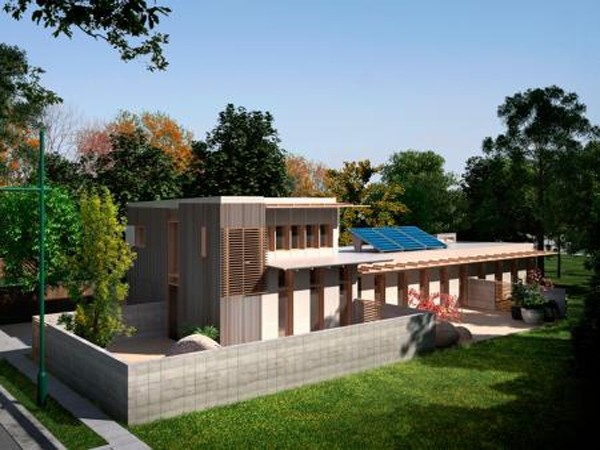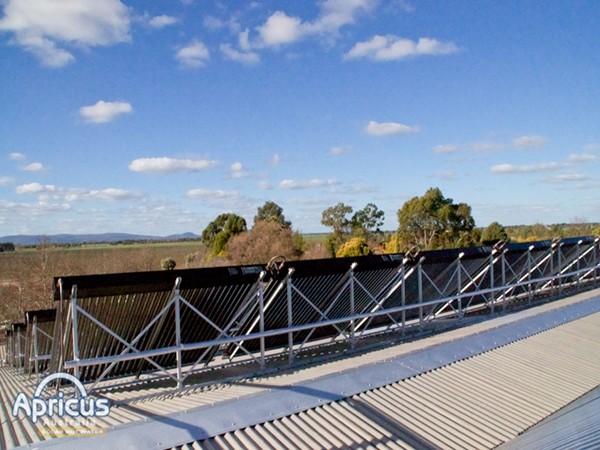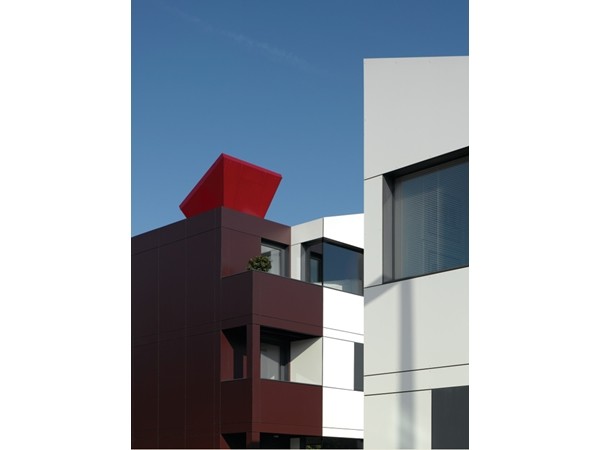When one thinks about solar hot water systems, an image of an expensive tank sticking out like a sore thumb beside a house might come into mind.
However, present systems are a long road away from the clunky and cost-ineffective things that they once were, and can offer both commercial and residential projects cost and design benefits.
Solar hot water systems (HWS) harness the sun’s natural energy to heat water. This is done via solar collectors, which take the form of flat plates or evacuated tubes. The heated water is then stored in an insulated tank for use when needed.
Designed to deliver hot water for most of the year, the advantages of solar water heaters are well-known.
On one hand, they help to lower costs. Water heating accounts for approximately a quarter of typical household energy usage, and utilising solar systems allows building owners to be financially better off.
On another, solar heating systems can contribute to lower carbon emissions.

Rinnai evacuated tube with no frame
Standard electric systems are used by about half of Australia’s eight million households. On average, they produce four tonnes of greenhouse gases each year – similar to an average-sized car, and around three times as much as solar or gas hot water systems (HWS).
While current energy efficiency data about commercial buildings is limited, it is safe to say that hot water energy usage does play a part in the emission of greenhouse gases in this space – albeit a smaller role than systems in residential projects.
This is confirmed by a November 2012 government report, ‘Baseline Energy Consumption and Greenhouse Gas Emissions in Commercial Buildings in Australia’, which shows that domestic hot water usage in all offices make up two per cent of electricity end use shares (1999-2012).
Switching to solar HWS can therefore help sites reduce their carbon footprints.
However, deciding if or what type of solar HWS to install requires consideration of a range of factors, including costs, suitability, installation ease, and design.
Systems in control
There are two types of solar water heaters. The first is a thermosiphon system, where the collector panels and storage tank are both mounted on the roof.

Thermosiphon or roof-mounted system. Image: www.solarpoweringyourhome.com
In this system, the liquid in the panels circulates into the tank via a thermosiphon effect. As water is heated up, it becomes lighter and rises into the tank without the need for a mechanical pump.
This heated water displaces cold water in the tank, which falls back into the solar collectors where the process continues.
While roof-mounted heaters free up space at the ground level and are highly energy efficient, they can weigh up to 300 kilograms and should only be mounted on sturdy roofs.
Moreover, crane fees might have to be factored into installation costs, which could end up becoming relatively expensive.
The second type of solar HWS is the ground-mounted system, which consists of slim solar collectors on the roof, and a water storage tank on the ground.

Ground-mounted or split system. Image: http://ee.ret.gov.au
A small electric pump circulates the water from the storage tank up to the collectors on the roof to be heated by the sun. The heated water is then returned to the tank.
This split system also requires an electric or gas booster, as well as a solar controller which, designed to avoid energy wastage and overheating water, decides when the pump should run.
Although ground-mounted systems are favoured for reducing the visual impact of roofs, they are often disadvantaged by added connection costs, which can soar if the distance between the system and tank is relatively vast.
Applications
To date, a large piece of the solar HWS pie has gone to the residential sector. For these projects, the ideal solar installation position should be north-facing and unhindered by tree and building shades.

Flip_Flop_House design developed by Lifehouse Design, Crosby Architects and Lewin Consulting for the BDAV 10 Star challenge competition. Image: lifehousedesign.com.au
“Solar positioning needs to be considered very early during the design stage,” explains Rheem’s sales manager, Tony Djodan.
“Otherwise, the solar back-up booster will be required to use an excessive amount of energy to heat the water during periods of low solar contribution, such as winter.”
To ensure the full realisation of system benefits, the roof should be designed to reflect the angle of maximum panel efficiency. This will prevent the need for a pitching frame, allowing direct installation to the roof.
Considering these elements early on will also help architects avoid conflicts with other elements of the design, or even the authorities.
In specifying these systems, it is important to ensure the solar system is sized correctly – the right number of solar panels must marry up with the correct sized storage tank. Installing four collectors with a 160 litre tank is therefore not ideal.
“As a guide only, one standard solar collector equals 150 litre of storage. Not sizing correctly calls for your back-up booster to heat the water unnecessarily, in turn using more energy, which defeats the purpose,” says Djodan.
Other key questions to ask when specifying solar water heaters for residential projects are:
- Does your project require frost or non-frost protection?
- Do you prefer a split solar design or a roof-mounted system? For the latter, roofs need to be reinforced due to the extra weight.
- Do you have a north-facing roof? If not, you may need to upsize your solar system
- Do you have natural gas on site for your back-up booster? Natural gas is a popular choice due to its lower running costs and low carbon dioxide output.
Although solar HWS are most commonly featured in residences, they have been increasingly employed in commercial projects.
Just recently, Apricus Australia completed the installation of a 200kW solar thermal plant – the largest solar thermal installation on a winery in Australasia.

De Bortoli Apricus solar hot water plant. Image: apricus.com.au
The De Bortoli winery in Griffith, NSW, features 3,000 Apricus solar tubes plugged into 100 Apricus AP30 manifolds at its new bottling plant. The collectors were mounted on a 37° pitch to maximise solar performance during the winter months.
Custom-designed specifically to the plant’s needs, the evacuated tubes pre-heat 12,000 litres of storage water, effectively reducing the winery’s gas consumption.
"After commissioning, the system was powered on from 8am with a starting water temperature of 20°C. The system achieved 12,000 litres of storage at a temperature of 71°C by 3.30pm,” reported Paul Fletcher of Fletcher Plumbing Co.

De Bortoli Apricus solar hot water plant. Image: apricus.com.au
However, Construction Systems Scientist at the CSIRO Michael Ambrose says the benefits of solar HWS on commercial projects can be incredibly wide and varied.
Depending on the type of building, it is not always worthwhile installing these systems.
“Large commercial office buildings have small hot water consumption rates, limited only to bathrooms and showers. To install big centralised systems may be inefficient because limited quantities of hot water have to be transported to various parts of the building,” said Ambrose.
The main problem here is the run times of the systems – the further away the collectors are from the point of use, the more the benefits offered with these systems are lost.
Solar HWS might also be an unsuitable choice where there is a demand for instantaneous hot water.
But, this does not mean that solar systems should be completely written off in commercial spaces. According to Ambrose, hotels and retail or smaller commercial developments are a different kettle of fish.
“These spaces have a relatively high rate of hot water consumption – high enough to warrant solar hot water systems, which would be effective.”
Smaller office buildings (1-2 storeys), shopping centres and even wineries that use large amounts of energy to generate hot water are therefore encouraged to include solar HWS.

The Wayside Chapel by environa studio. Photography by Owen Zhu
Key tips for specifying a commercial solar plant:
- Use systems manufactured by one company, which eliminates further warranty and design or installation issues.
- Systems should also be durable, such as stainless steel storage tanks and a commercial fixture kit for sound structural installation of the panels.
An important consideration when approaching commercial applications is to know how much contribution is required annually for the building. No solar system can provide 100 per cent of a large commercial operation’s needs throughout the year. Depending on the location, there is typically a maximum of 80 per cent.
A second key factor is deciding how much roof or plant room areas are available for the collectors and storage tanks.
“We always consider plant space first and then determine the possible solar contribution,” says Rheem’s technical marketing manager, David Micallef.

Rinnai commercial solar collectors
Patrick Hooper, hot water product manager of Rinnai Australia, adds a third element to the aforementioned space and contribution factors: capital expenditure.
“Commercial solar systems costs can vary greatly depending on decisions made around these three main questions,” he says. It can also be hard to persuade clients to pay for the infrastructure.
“But there are many suppliers coming to the market with cheaper imports. This has certainly driven down the cost of solar systems over the years.”
Hooper adds that large systems do not necessarily maximise returns. Except for very small systems, solar contribution is generally linear with capital expenditure.
Some also suggest that long-term savings will offset all initial costs, especially with solar hot water rebates.
While solar solar hot water systems have many benefits, the issue of cost and energy savings seldom nullifies the problem of aesthetics.

Oxley Park Housing by Milton Keynes and Rogers Stirk Harbour + Partners features the 'Eco hat', which heats water via solar power. Image: Richard Bryant/Arcaid.co.uk
Do you think good design can be reconciled with energy efficient solar HWS? Are these systems merely 'add-on' features to a well-designed project, or do they have the potential to be a key part of the design?
Click here for PART TWO of the series, which looks at whether sustainability can be reconciled with good design for solar hot water systems.

